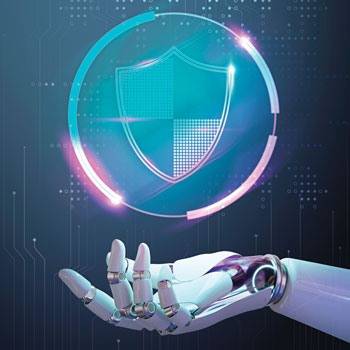AI – Cybersecurity's guardian Angel

Cybersecurity plays a crucial role in strengthening a company's privacy and security. And now, AI is ensuring that everything is falling into place, and security is reaching unprecedented levels. In that light, Corporate Citizen talks to Manpreet Singh Sabharwal, VP of Infrastructure and Information Security at Visionet Systems Inc., to understand how AI is revolutionising cybersecurity
CC: What is AI in cybersecurity? And, why is AI in cybersecurity important?
Manpreet Singh Sabharwal: AI in cybersecurity leverages algorithms to enhance security measures, protect systems, and detect and respond to threats in real time. There are several reasons why cybersecurity has become the need of the hour. For instance, AI tools can analyse vast amounts of data, recognise patterns, and make decisions autonomously, or assist human experts in identifying, preventing and mitigating cyberattacks. This is one of the most important reasons why organisations are embracing it. Additionally, AI has become so versatile that it can process and analyse data in real time, helping identify threats faster and more accurately. AI systems can detect and respond to threats in milliseconds, allowing for automated, real-time defences and reducing the impact of cyberattacks. AI can be used to shift from a reactive to a proactive security posture, which is very important from a cybersecurity perspective.
CC: What are the main ways AI is being used in cybersecurity today?
Owing to its nature, AI is used in multiple ways to enhance a system. Following are the ways:
Threat detection and prevention: AI is being used to identify cyber threats in real time, often before they can cause significant damage. It uses ML algorithms to analyse network traffic, logs, and other data, to spot anomalies that might indicate malicious activity.
Automated response and mitigation: AI-driven systems can respond to threats in real time, reducing the need for human intervention and speeding up the process of containment and remediation.
Predictive threat intelligence: AI can analyse vast amounts of historical data and patterns to predict potential future attacks and vulnerabilities, offering organisations to act proactively rather than reactively.
Endpoint protection: Endpoints (e.g., laptops, mobile devices, etc) are often the entry points for cyberattacks. AI is increasingly being used to secure these devices through real-time threat detection, behavioural analysis, and autonomous response.
Phishing detection and prevention: Phishing attacks, which involve tricking users into revealing sensitive information, are one of the most common forms of cybercrime. AI is increasingly used to detect phishing attempts before they can succeed.
CC: How is AI transforming the corporate cybersecurity landscape?
One of the most pressing challenges faced by corporations today is detecting and responding to threats effectively. AI is revolutionising corporate cybersecurity by introducing unparalleled accuracy in threat detection, slashing response times, automating repetitive tasks, and proactively outsmarting cybercriminals. With its capability to analyse vast datasets in real-time, AI unveils hidden patterns, predicts potential vulnerabilities, and reinforces defences before threats materialise.
As cyber threats grow increasingly sophisticated, traditional methods often fall short. AI, however, offers corporations an edge—turning vast data streams into actionable insights, enabling swift, intelligent decision-making, and creating an adaptive shield against ever-changing attack vectors. By seamlessly integrating AI into their cybersecurity frameworks, organisations can tackle once insurmountable challenges. In this age of digital transformation, where data is the new currency, AI stands as the ultimate guardian. Its role is not just important—it’s indispensable, shaping the future of secure corporate ecosystems.
CC: Is Deep Neural Networks being used?
Yes, Deep Neural Networks are increasingly being used in cybersecurity, and they play a crucial role in enhancing threat detection, anomaly recognition and predictive analytics.
"To stay relevant in an AI-driven cybersecurity future, professionals must blend traditional security expertise with a strong understanding of AI and machine learning"
-Manpreet Singh Sabharwal
CC: What are the risks of AI being used maliciously by cyber criminals?

As AI technology becomes more accessible and sophisticated, cybercriminals are increasingly leveraging AI and Machine Learning, to enhance their attacks and evade detection. AI can enable cybercriminals to automate and refine their attack strategies, making them faster, more targeted, and harder to detect. Deepfakes, which are AI-generated media (images, videos, or audio), have become a significant tool for cybercriminals in disinformation campaigns and identity theft. AI itself is a potential target. Cybercriminals may try to corrupt, manipulate, or poison AI models to subvert the security defences they are designed to protect. There have been many incidents which have caused corporates and individuals to lose money due to deepfakes videos.
CC: What challenges do organisations face when implementing AI in their cybersecurity strategies?
While AI holds tremendous promise for enhancing cybersecurity, its implementation comes with a range of challenges. These include data-related issues, complexity, the need for specialised expertise, ethical concerns, and the constant threat of adversarial AI attacks. One of the challenges is to build controls around AI.
CC: What skills should cybersecurity professionals develop to stay relevant in an AI-driven future?
To stay relevant in an AI-driven cybersecurity future, professionals must blend traditional security expertise with a strong understanding of AI and Machine Learning. This means becoming proficient in AI technologies, learning how to integrate AI tools into existing systems, and understanding how to defend against AI-powered threats. Furthermore, they should develop skills in data science, automation, and risk management, while staying adaptable to new technologies and ethical considerations.
CC: What’s one thing you wish more people understood about AI and its role in cybersecurity?
It is said that “AI is likely to be the best or worst thing to happen to humanity.” As we have embraced most technologies with open arms, we should do the same with AI. We should understand this technology better and use it for our benefit. One thing I wish more people understood about AI is that it is a tool, not a replacement for human expertise or knowledge. While AI can significantly enhance cybersecurity by automating routine tasks, detecting patterns, and responding to threats in real-time, it still requires human oversight and intervention. Human judgement is essential to interpret the results, understand the broader context, and make decisions based on AI-driven insights.